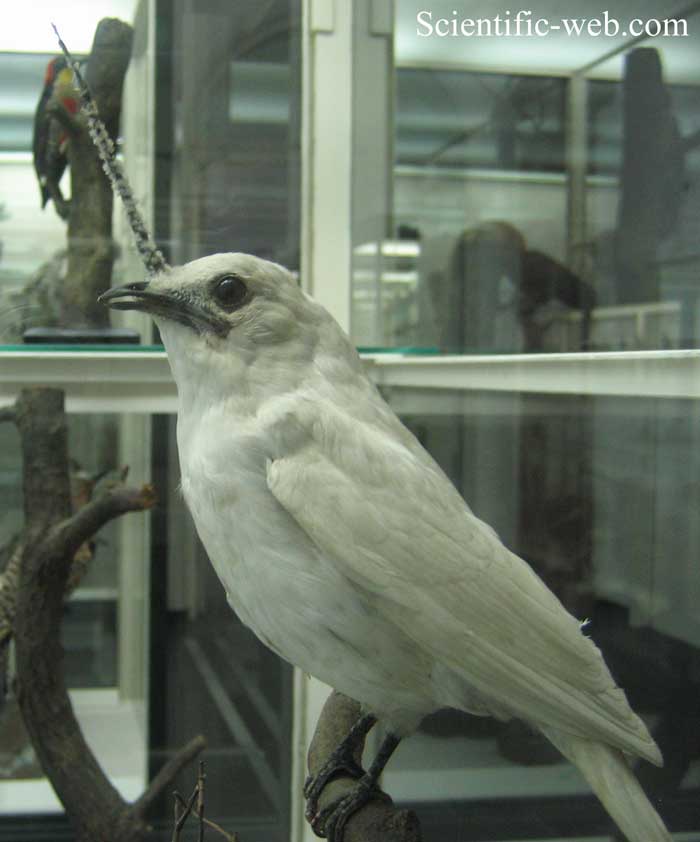
Procnias albus, Photo: Michael Lahanas
Superregnum: Eukaryota
Cladus: Unikonta
Cladus: Opisthokonta
Cladus: Holozoa
Regnum: Animalia
Subregnum: Eumetazoa
Cladus: Bilateria
Cladus: Nephrozoa
Superphylum: Deuterostomia
Phylum: Chordata
Subphylum: Vertebrata
Infraphylum: Gnathostomata
Megaclassis: Osteichthyes
Cladus: Sarcopterygii
Cladus: Rhipidistia
Cladus: Tetrapodomorpha
Cladus: Eotetrapodiformes
Cladus: Elpistostegalia
Superclassis: Tetrapoda
Cladus: Reptiliomorpha
Cladus: Amniota
Classis: Reptilia
Cladus: Eureptilia
Cladus: Romeriida
Subclassis: Diapsida
Cladus: Sauria
Infraclassis: Archosauromorpha
Cladus: Crurotarsi
Divisio: Archosauria
Cladus: Avemetatarsalia
Cladus: Ornithodira
Subtaxon: Dinosauromorpha
Cladus: Dinosauriformes
Cladus: Dracohors
Cladus: Dinosauria
Cladus: Saurischia
Cladus: Eusaurischia
Subordo: Theropoda
Cladus: Neotheropoda
Cladus: Averostra
Cladus: Tetanurae
Cladus: Avetheropoda
Cladus: Coelurosauria
Cladus: Tyrannoraptora
Cladus: Maniraptoromorpha
Cladus: Maniraptoriformes
Cladus: Maniraptora
Cladus: Pennaraptora
Cladus: Paraves
Cladus: Eumaniraptora
Cladus: Avialae
Infraclassis: Aves
Cladus: Avebrevicauda
Cladus: Pygostylia
Cladus: Ornithothoraces
Cladus: Ornithuromorpha
Cladus: Carinatae
Parvclassis: Neornithes
Cohors: Neognathae
Cladus: Neoaves
Cladus: Telluraves
Cladus: Australaves
Ordo: Passeriformes
Subordo: Tyranni
Infraordo: Tyrannides
Parvordo: Tyrannida
Familia: Cotingidae
Genus: Procnias
Species: Procnias albus
Subspecies: P. a. albus – P. a. wallacei
Name
Procnias albus (Hermann, 1783)
Type locality: Cayenne, French Guiana.
Synonymy
Ampelis alba (protonym)
Procnias alba (Hermann, 1783)
Chasmorhynchus niveus Cabanis & Heine Sr., 1859 Mus.Hein 2 p. 108 BHL
Casmarhynchus niveus
References
Hermann, J. 1783. Tabula affinitatum animalium olim academico specimine edita, nunc uberiore commentario illustrata com annotationibus ad historiam naturalem animalium augendam facientibus. Joh. Georgii Treuttel. Argentorati [Strasbourg]. i–xvi, 1–371 BHL Reference page. p. 213
Vernacular names
English: White Bellbird
español: Campanero blanco
galego: Campaneiro branco
português: Araponga-da-amazônia
The white bellbird (Procnias albus) is a species of bird in the family Cotingidae. It is the world’s loudest bird, producing vocalizations of up to 125.4 decibels. The specific epithet is often spelled alba, but albus is correct due to the masculine gender of "Procnias". It is found in forests in the Guianas, with small numbers in Venezuela and the Brazilian state of Pará, as well as Trinidad and Tobago and Panama. As in two other members of Procnias, the males have wattles, fleshy structures akin to the red skin flap that hangs from the throat of roosters.
Description
A taxidermied male, with the wattle incorrectly positioned as being raised rather than hanging down
Photo of a dead bird on display. The bird is belly-up. It is mostly brown with white and yellow streaks on its underside.
A preserved specimen of a female white bellbird
The white bellbird grows to a length of about 28 cm (11 in). The male is pure white with a black bill that has a fleshy black wattle, sparsely feathered with white feathers, dangling from its top and hanging down the side, usually the right side; the female is an overall olive colour, with olive streaks on the yellowish underparts, and resembles other bellbirds. The male is unlikely to be mistaken for anything else, but the female resembles the bearded bellbird (Procnias averano); that bird has a dusky olive crown and black streaking on the throat.[2]
According to a study published in 2019, the white bellbird produces the loudest call ever recorded in a bird, reaching 125 dB(A) (at equivalent 1m distance).[3][4] The record was previously held by the screaming piha, which was recorded at 116 dB.[5]
Distribution and habitat
[icon]
This section needs expansion. You can help by adding to it. (December 2022)
The range of the white bellbird includes parts of Brazil, French Guiana, Guyana, Suriname, Trinidad and Tobago, and Venezuela. It occurs in moist tropical or subtropical forests.[6]
Behaviour and ecology
Status
Although the white bellbird is an uncommon bird, its total population is estimated to be large. The population may be in slight decline because of deforestation, but not at a fast enough rate for it to be considered threatened, so the International Union for Conservation of Nature has rated its conservation status as being of "least concern".[1]
References
BirdLife International (2016). "Procnias albus". IUCN Red List of Threatened Species. 2016: e.T22700957A93806627. doi:10.2305/IUCN.UK.2016-3.RLTS.T22700957A93806627.en. Retrieved 12 November 2021.
Ridgely, Robert S.; Tudor, Guy (2009). Field Guide to the Songbirds of South America: Vol. II, The Suboscine Passerines. University of Texas Press. p. 762. ISBN 978-0-292-71748-0.
Jeffrey Podos; Mario Cohn-Haft (21 October 2019). "Extremely loud mating songs at close range in white bellbirds". Current Biology. 29 (20): R1068–R1069. Bibcode:2019CBio...29R1068P. doi:10.1016/j.cub.2019.09.028. PMID 31639347. S2CID 204823663.
"World's 'loudest bird': Meet the white bellbird". Newsbeat (video). BBC News. 22 October 2019.
NEMETH, ERWIN (1 January 2004). "Measuring the Sound Pressure Level of the Song of the Screaming Piha Lipaugus Vociferans: One of the Loudest Birds in the World?". Bioacoustics. 14 (3): 225–228. Bibcode:2004Bioac..14..225N. doi:10.1080/09524622.2004.9753527. ISSN 0952-4622. S2CID 84218370.
BirdLife International (2016). "Procnias albus". IUCN Red List of Threatened Species. doi:10.2305/IUCN.UK.2016-3.RLTS.T22700957A93806627.en. Retrieved 22 December 2022.
Further reading
Snow, D.W. (1982). The Cotingas: Bellbirds, Umbrella birds and their allies. British Museum Press. ISBN 0-19-858511-X
Retrieved from "http://en.wikipedia.org/"
All text is available under the terms of the GNU Free Documentation License

